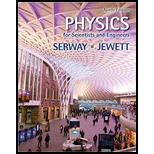
Concept explainers
(i)
The nature of the propagation of the gap.
(i)
Answer to Problem 16.1QQ
Option (b) is correct.
Explanation of Solution
In a transverse wave the disturbance in the medium is perpendicular to the direction of propagation. In a longitudinal wave the disturbance in the medium is parallel to the direction of propagation.
In this case, the direction of propagation of the wave is towards the ticket window. When one person leaves, the gap is filled by the next person step forward to fill the gap it means the disturbance in the medium is also towards the ticket window.
As the disturbance in the medium and the direction of propagation both are in the same direction that is parallel to each other therefore, the propagation of gap is longitudinal.
Conclusion:
The disturbance in the medium and the direction of propagation are not perpendicular. Hence, Option (a) is not correct.
The disturbance in the medium and the direction of propagation are in the same direction. Hence, Option (b) is correct.
(ii)
The resultant pulse moves around the stadium and the pulse is (a) transverse or (b) longitudinal
(ii)
Answer to Problem 16.1QQ
Option (a) is correct.
Explanation of Solution
In a transverse wave the disturbance in the medium is perpendicular to the direction of propagation. In a longitudinal wave the disturbance in the medium is parallel to the direction of propagation.
In this case, the people stand up of sit down whereas the pulse moves either to the left or to the right. So, the disturbance in the medium and the direction of propagation of the pulse are perpendicular to each other.
The direction of propagation of the pulse and the disturbance in the medium are perpendicular to each other therefore, the pulse is transverse.
Conclusion:
The direction of propagation of the pulse and the disturbance in the medium are perpendicular. Hence, Option (a) is correct.
The direction of propagation of the pulse and the disturbance in the medium are not in the same direction. Hence, Option (b) is not correct.
Want to see more full solutions like this?
Chapter 16 Solutions
PHYSICS 1250 PACKAGE >CI<
- 20. Two small conducting spheres are placed on top of insulating pads. The 3.7 × 10-10 C sphere is fixed whie the 3.0 × 107 C sphere, initially at rest, is free to move. The mass of each sphere is 0.09 kg. If the spheres are initially 0.10 m apart, how fast will the sphere be moving when they are 1.5 m apart?arrow_forwardpls help on allarrow_forwardpls help on thesearrow_forward
- pls help on all asked questions kindlyarrow_forwardpls help on all asked questions kindlyarrow_forward19. Mount Everest, Earth's highest mountain above sea level, has a peak of 8849 m above sea level. Assume that sea level defines the height of Earth's surface. (re = 6.38 × 106 m, ME = 5.98 × 1024 kg, G = 6.67 × 10 -11 Nm²/kg²) a. Calculate the strength of Earth's gravitational field at a point at the peak of Mount Everest. b. What is the ratio of the strength of Earth's gravitational field at a point 644416m below the surface of the Earth to a point at the top of Mount Everest? C. A tourist watching the sunrise on top of Mount Everest observes a satellite orbiting Earth at an altitude 3580 km above his position. Determine the speed of the satellite.arrow_forward
- pls help on allarrow_forwardpls help on allarrow_forward6. As the distance between two charges decreases, the magnitude of the electric potential energy of the two-charge system: a) Always increases b) Always decreases c) Increases if the charges have the same sign, decreases if they have the opposite signs d) Increases if the charges have the opposite sign, decreases if they have the same sign 7. To analyze the motion of an elastic collision between two charged particles we use conservation of & a) Energy, Velocity b) Momentum, Force c) Mass, Momentum d) Energy, Momentum e) Kinetic Energy, Potential Energyarrow_forward
 Principles of Physics: A Calculus-Based TextPhysicsISBN:9781133104261Author:Raymond A. Serway, John W. JewettPublisher:Cengage Learning
Principles of Physics: A Calculus-Based TextPhysicsISBN:9781133104261Author:Raymond A. Serway, John W. JewettPublisher:Cengage Learning Physics for Scientists and Engineers: Foundations...PhysicsISBN:9781133939146Author:Katz, Debora M.Publisher:Cengage Learning
Physics for Scientists and Engineers: Foundations...PhysicsISBN:9781133939146Author:Katz, Debora M.Publisher:Cengage Learning University Physics Volume 1PhysicsISBN:9781938168277Author:William Moebs, Samuel J. Ling, Jeff SannyPublisher:OpenStax - Rice University
University Physics Volume 1PhysicsISBN:9781938168277Author:William Moebs, Samuel J. Ling, Jeff SannyPublisher:OpenStax - Rice University Glencoe Physics: Principles and Problems, Student...PhysicsISBN:9780078807213Author:Paul W. ZitzewitzPublisher:Glencoe/McGraw-Hill
Glencoe Physics: Principles and Problems, Student...PhysicsISBN:9780078807213Author:Paul W. ZitzewitzPublisher:Glencoe/McGraw-Hill Physics for Scientists and EngineersPhysicsISBN:9781337553278Author:Raymond A. Serway, John W. JewettPublisher:Cengage Learning
Physics for Scientists and EngineersPhysicsISBN:9781337553278Author:Raymond A. Serway, John W. JewettPublisher:Cengage Learning Physics for Scientists and Engineers with Modern ...PhysicsISBN:9781337553292Author:Raymond A. Serway, John W. JewettPublisher:Cengage Learning
Physics for Scientists and Engineers with Modern ...PhysicsISBN:9781337553292Author:Raymond A. Serway, John W. JewettPublisher:Cengage Learning





